Related Research Articles
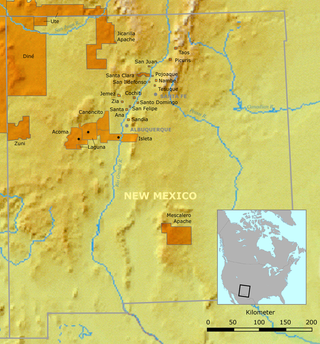
The Puebloans, or Pueblo peoples, are Native Americans in the Southwestern United States who share common agricultural, material, and religious practices. Among the currently inhabited Pueblos, Taos, San Ildefonso, Acoma, Zuni, and Hopi are some of the most commonly known. Pueblo people speak languages from four different language families, and each Pueblo is further divided culturally by kinship systems and agricultural practices, although all cultivate varieties of maize.
Zuni religion is the oral history, cosmology, and religion of the Zuni people. The Zuni are a Pueblo people located in New Mexico. Their religion is integrated into their daily lives and respects ancestors, nature, and animals. Because of a history of religious persecution by non-native peoples, they are very private about their religious beliefs. Roman Catholicism has to some extent been integrated into traditional Zuni religion.

A kachina is a spirit being in the religious beliefs of the Pueblo people, Native American cultures located in the south-western part of the United States. In the Pueblo cultures, kachina rites are practiced by the Hopi, Hopi-Tewa and Zuni peoples and certain Keresan tribes, as well as in most Pueblo tribes in New Mexico.

The Zuni are Native American Pueblo peoples native to the Zuni River valley. The Zuni people today are federally recognized as the Zuni Tribe of the Zuni Reservation, New Mexico, and most live in the Pueblo of Zuni on the Zuni River, a tributary of the Little Colorado River, in western New Mexico, United States. The Pueblo of Zuni is 55 km (34 mi) south of Gallup, New Mexico. The Zuni tribe lived in multi level adobe houses. In addition to the reservation, the tribe owns trust lands in Catron County, New Mexico, and Apache County, Arizona. The Zuni call their homeland Halona Idiwan’a or Middle Place. The word Zuni is believed to derive from the Western Keres language (Acoma) word sɨ̂‧ni, or a cognate thereof.

Pueblo refers to the settlements and to the Native American tribes of the Pueblo peoples in the Southwestern United States, currently in New Mexico, Arizona, and Texas. The permanent communities, including some of the oldest continually occupied settlements in the United States, are called pueblos (lowercased).

Frank Hamilton Cushing was an American anthropologist and ethnologist. He made pioneering studies of the Zuni Indians of New Mexico by entering into their culture; his work helped establish participant observation as a common anthropological research strategy. In recent years, however, questions have emerged about Cushing's activities among the Zuni. Consequently, Frank Cushing's work provides an important case study for considering the ethics of both ethnographic research and the generation of museum collections.
Pueblo music includes the music of the Hopi, Zuni, Taos Pueblo, San Ildefonso, Santo Domingo, and many other Puebloan peoples, and according to Bruno Nettl features one of the most complex Native American musical styles on the continent. Characteristics include common use of hexatonic and heptatonic scales, variety of form, melodic contour, and percussive accompaniment, melodic range averaging between an octave and a twelfth, with rhythmic complexity equal to the Plains Indians musical sub-area.
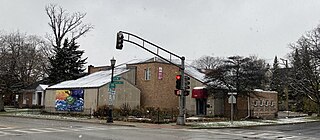
The Mitchell Museum of the American Indian is a museum in Evanston, Illinois that focuses exclusively on the history, culture and arts of North American native peoples. It is a Core Member of the Chicago Cultural Alliance, a consortium of 25 ethnic museums and cultural centres in Chicago.

Pueblo of Isleta is an unincorporated community and Tanoan pueblo in Bernalillo County, New Mexico, United States, originally established in the c. 14th century. The Southern Tiwa name of the pueblo is Shiewhibak (Shee-eh-whíb-bak) meaning "a knife laid on the ground to play whib", a traditional footrace. Its people are a federally recognized tribe.
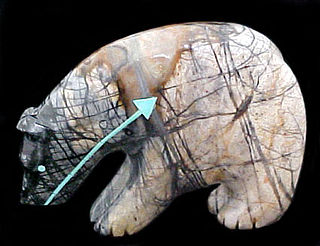
Zuni fetishes are small carvings made from primarily stone but also shell, fossils, and other materials by the Zuni people. Within the Zuni community, these carvings serve ceremonial purposes for their creators and depict animals and icons integral to their culture. As a form of contemporary Native American art, they are sold with secular intentions to collectors worldwide. Prior to the establishment of a non-Native market for fetishes, Hopi, Navajo, and other Pueblo peoples, especially at Kewa Pueblo also carved and used fetishes.
In the myths of the Pueblo Zuni people of New Mexico, Awonawilona is known as the "Supreme life-giving power" and the creator of all with a name translating to "All Container". The deity's gender is not specified in myth and referred to as either he or she. In the beginning, Awonawilona created and became all configurations of water in the world; as a result fog, clouds, large bodies of water, and air were formed. In other versions, fog and steam were already existent before Awonawilona. The new combination of light, clouds, and air allowed for vegetation and made Awonawilona the "essence" of life as they created the universe. The universe was made up of 9 layers: the first layer was the earth and the other 8 were homes for various animals, birds, and trees.
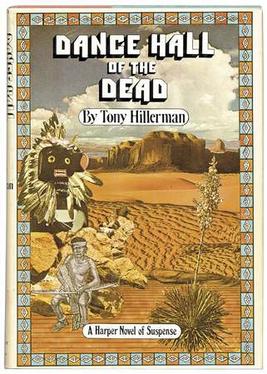
Dance Hall Of The Dead is a crime novel by American writer Tony Hillerman, the second in the Joe Leaphorn/Jim Chee Navajo Tribal Police series, first published in 1973. It features police Lieutenant Joe Leaphorn. It is set primarily in Ramah Reservation and the Zuni village in New Mexico, both in the American Southwest.
In Hopi mythology, Angak or Angak'china is a male Hopi kachina spirit, represented by spirit dancers and a corresponding kachina doll figure, known to non-hopis as Longhair or Long Hair. Angak is originally from the Zuni Pueblo. The goal of the Angak spirit is to bring rain and flowers to the Hopi villages. Angak sings sweet songs to bring rain. Further, he represents a healing and protective figure. There are many varieties of Angak, such as the red-bearded Hokyan Angak'china. He is present and relatively popular throughout the Hopi and Hopi-Tewa areas of Arizona and New Mexico.
Soyal is the winter solstice ceremony of the Zuni and Hopi peoples held December 21, the shortest day of the year. Participants ceremonially bring the sun back from its long slumber, mark the beginning of another cycle of the Wheel of the Year, and work on purification. Pahos prayer sticks are made prior to the Soyal ceremony, to bless all the community, including homes, animals, and plants. The sacred underground kiva chambers are ritually opened to mark the beginning of the Kachina season.

The Pueblo clowns are jesters or tricksters in the Kachina religion. It is a generic term, as there are a number of these figures in the ritual practice of the Pueblo people. Each has a unique role; belonging to separate Kivas and each has a name that differs from one mesa or pueblo to another.
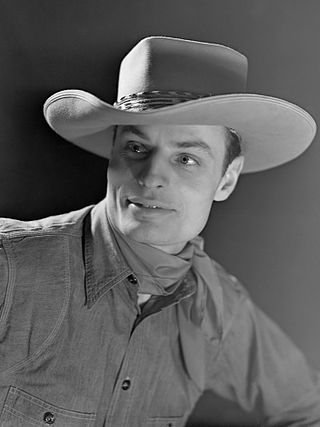
Paul Coze was a French/Serbian-American anthropologist, artist, and writer, most notable as a French authority on Native Americans, and for his public art in the 1960s.
In Hopi mythology Nataska is the uncle of the family of "ogre Katsinas" who guard Soyok Wuhti, and who enforce good behavior among the children. Nataska is a Mongkatsina. Wiharu is a similar or identical Katsina with a white rather than black face.
In the religious beliefs of the Native American Pueblo people, Toho is a hunter kachina for the Hopi and Zuni tribes. Toho, The mountain lion kachina, often accompanies such animals as the deer or antelope kachinas when they appear in the Line Dances of spring. Armed with yucca whips, he patrols the procession in company with He-e-e, Warrior Woman, and other warrior or guard kachinas. Thought to be the most powerful hunter, the Toho is the guardian of the northern direction. He is associated with the color yellow and appears in both hunting and healing fetish sets, always facing north. Toho can be represented by a naked man wearing a mask, whiskers, and yellow feathers upon either side of his head to look like the lion's ears, or carved as a mountain lion fetish in an ancient, primitive style. Most mountain lion fetishes are represented with their tails up and over the back. Toho is there to remind individuals to persevere, clarify goals, and move forward to achieving dreams. He steadies the hunter and protects his territory.

Art of the American Southwest is the visual arts of the Southwestern United States. This region encompasses Arizona, New Mexico, and parts of California, Colorado, Nevada, Texas, and Utah. These arts include architecture, ceramics, drawing, filmmaking, painting, photography, sculpture, printmaking, and other media, ranging from the ancient past to the contemporary arts of the present day.

Dowa Yalanne is a steep mesa 3.1 miles (5 km) southeast of the present Pueblo of Zuni, on the Zuni Indian Reservation. Plainly visible from the Zuni Pueblo, the mesa is located in McKinley County, New Mexico, and has an elevation of 7,274 feet (2,217 m). The mesa is a sacred place for the Zuni people, who fled to the mesa top to escape the Coronado expedition in 1540, and it is closed to outside visitors.
References
- ↑ "Zuni - Religion and Expressive Culture." (retrieve 21 Nov 2011)
- ↑ Bonvillain, Nancy (2011). The Zuni. New York: Chelsea House. pp. 36–37. ISBN 9781604137996.
- 1 2 3 4 Wright, Barton (1988). Patterns and Sources of Zuni Kachinas. Hamsen Publishing Company. pp. 42–45, 80–101. ISBN 9780960132249.
- ↑ Cushing, Frank (1896). Outlines of Zuni Creation Myths. Pennsylvania. pp. 401–403. ISBN 9781508654377.
{{cite book}}: CS1 maint: location missing publisher (link) - ↑ Cushing, Frank (1988). The Mythic World of the Zuni. Albuquerque: University of New Mexico Press. pp. 49–51. ISBN 9780826313874.